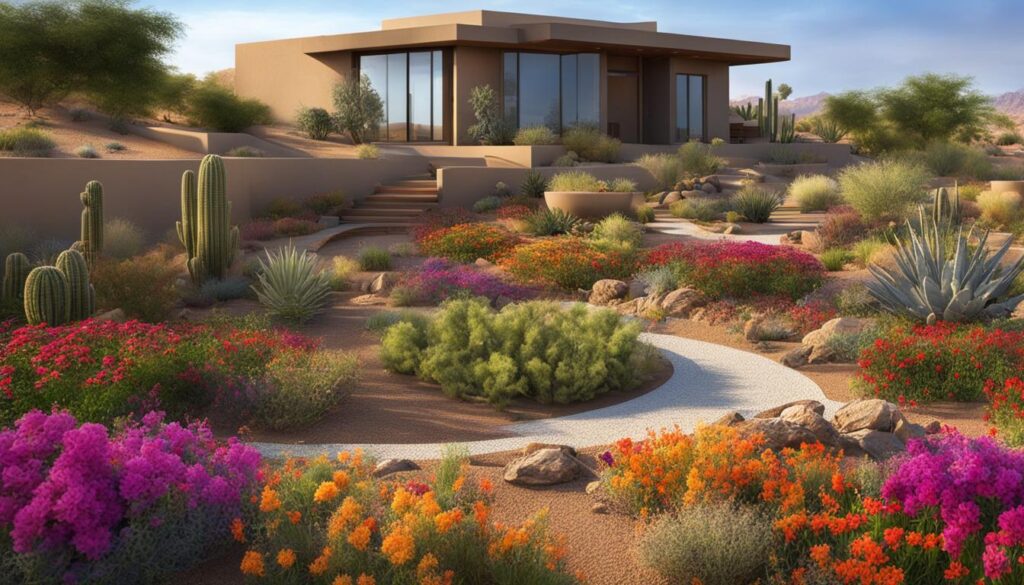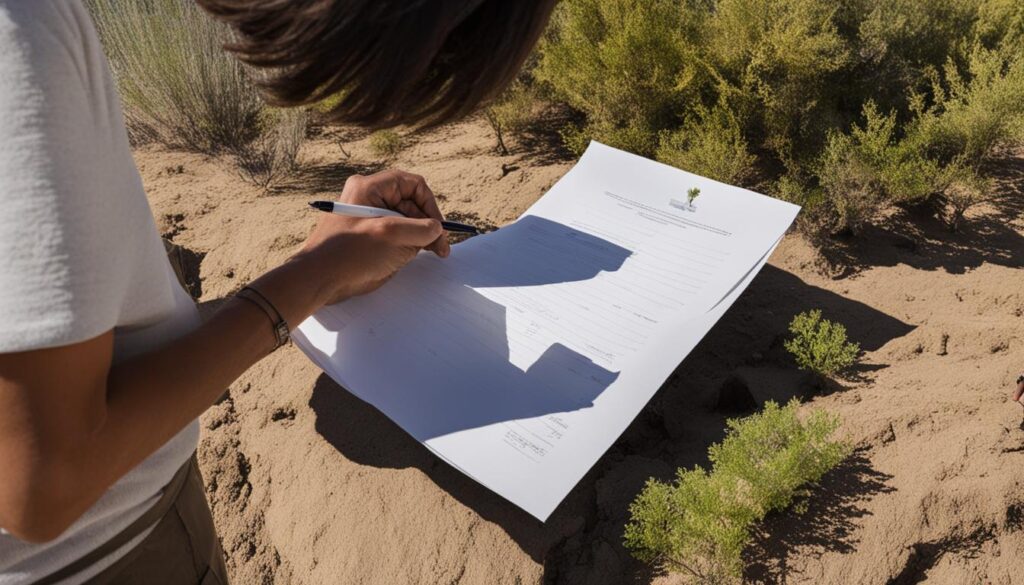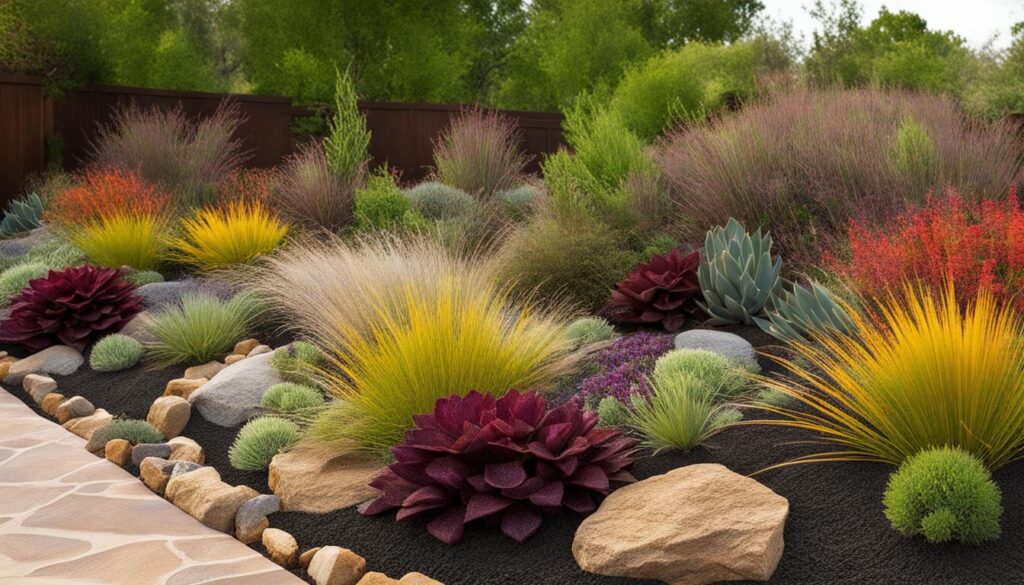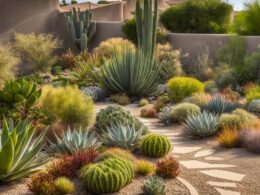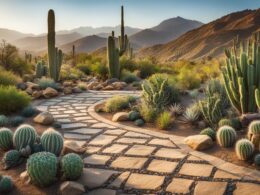Xeriscape is a landscaping design that aims to minimize water consumption by using drought-tolerant plants and materials that require little to no additional water. Native plants are particularly valuable for their ability to thrive in specific regions and support local ecosystems. Incorporating native plants in your landscape can improve biodiversity, attract wildlife, and reduce the need for excessive maintenance and resources.
Key Takeaways:
- Xeriscape is a landscaping design that promotes water conservation and reduces maintenance.
- Native plants are beneficial for their ability to thrive in specific regions and support local ecosystems.
- Xeriscaping can improve biodiversity, attract wildlife, and minimize the need for excessive maintenance and resources.
- By incorporating drought-tolerant plants, homeowners can create a sustainable and eco-friendly landscape.
- Xeriscaping can contribute to water efficiency and landscape sustainability.
Benefits of Xeriscaping
Xeriscaping offers numerous benefits for homeowners and the environment. By reducing water usage, xeriscaping can lower water bills and save money. Drought-tolerant plants require less ongoing maintenance, reducing the need for mowing, watering, and the use of chemicals. This results in cost savings and less impact on the environment.
According to a study by the Environmental Protection Agency, xeriscaping can reduce water usage by up to 50-75% compared to traditional landscaping methods. This significant reduction in water consumption not only helps conserve this valuable resource, but it also contributes to the overall sustainability of our environment.
“Xeriscaping not only saves water and reduces maintenance but also has a positive impact on the environment. It promotes the conservation of water resources and helps mitigate the effects of droughts. By choosing native plants and implementing efficient irrigation systems, homeowners can make a significant contribution to water conservation efforts.”
In addition to the environmental benefits, xeriscaping also enhances the value of a home. As more buyers prioritize sustainable and low-maintenance landscaping, properties with xeriscaped yards are becoming increasingly attractive. A well-designed xeriscape can boost curb appeal, increase property value, and set your home apart in the real estate market.
Key Benefits of Xeriscaping:
- Water conservation
- Cost savings on water bills
- Reduced maintenance requirements
- Positive environmental impact
- Increased home value
In summary, xeriscaping offers a range of benefits for both homeowners and the environment. By implementing water-efficient practices, homeowners can save money, reduce maintenance, and contribute to a more sustainable future. With the added bonus of increasing property value, xeriscaping is a win-win solution for homeowners looking to create beautiful, low-maintenance landscapes while conserving water.
Planning a Xeriscaping Project
When embarking on a xeriscaping project, it’s essential to carefully plan and consider various factors to ensure successful implementation. The following steps will guide you in creating an efficient and sustainable xeriscape:
- Assess the scope: Start by evaluating the scope of your project. Determine the areas of your landscape that you want to convert to xeriscaping and the goals you aim to achieve. This assessment will help you allocate resources and prioritize tasks.
- Water zones: Dividing your landscape into distinct water zones is crucial for efficient water use. Identify areas that require different levels of watering, such as low-water, moderate-water, or high-water zones. By grouping plants with similar water needs together, you can optimize irrigation and ensure plants receive the appropriate amount of water.
- Choose native plants: Selecting region-appropriate native plants is key to a successful xeriscape. Native plants have adapted to the local climate, soil conditions, and rainfall patterns, making them more resistant to drought and disease. They require less water and maintenance compared to non-native plants. Research local nurseries or consult with a landscaper to discover the best native plants for your region.
- Implement efficient irrigation: Installing the right irrigation system is essential for water conservation in xeriscapes. Drip irrigation is highly recommended as it delivers water directly to the plant’s root zone, reducing evaporation and water waste. Consider incorporating smart irrigation controllers that adjust watering schedules based on weather conditions, further optimizing water usage.
- Maintain regularly: Although xeriscapes require less maintenance than traditional landscapes, regular upkeep is still necessary for their long-term health and attractiveness. Pruning, mulch replacement, and occasional weed control are essential tasks to preserve the beauty and functionality of your xeriscape.
Implementing these key steps during the planning phase of your xeriscaping project will ensure long-term success and water efficiency. By considering the scope, water zones, native plants, irrigation methods, and maintenance requirements, you can create a beautiful and sustainable xeriscape that conserves water and benefits both the environment and your wallet.
Can Pruning and Trimming Help with Xeriscape Plant Replacement?
Pruning xeriscape plants can be beneficial for plant replacement. Trimming dead or overgrown branches can encourage new growth and improve the overall health of the plant. It also allows for more effective water conservation in xeriscaping, helping to maintain a sustainable and low-maintenance landscape.
Replacing a Lawn
If you’re looking to conserve water and reduce ongoing maintenance, replacing a significant portion of your lawn with alternative materials can be a game-changer. Not only will this help you save on water bills, but it will also contribute to a more sustainable landscape. One of the best alternatives to consider is mulch. Applying a layer of mulch not only helps retain moisture in the soil but also improves its quality. Plus, it adds an aesthetic appeal to your outdoor space.
In addition to mulch, rocks and gravel are also excellent options for replacing your lawn. These materials not only curb weed growth but also enhance drainage, preventing water from pooling in your yard. By incorporating rocks and gravel strategically, you can create beautiful pathways or decorative accents that add visual interest to your landscape.
When it comes to selecting plants for your lawn replacement, prioritize indigenous or native species. These plants are well-adapted to the local climate conditions and require less watering. By choosing indigenous plants, you’ll ensure that your landscape remains vibrant and green, even during dry spells. Plus, they provide habitat and food for local wildlife, contributing to the overall biodiversity of your yard.
Efficient irrigation is key
While replacing your lawn with alternative materials and indigenous plants is a step in the right direction, it’s important to implement an efficient irrigation system. Drip irrigation, for example, delivers water directly to the roots of plants, minimizing wastage and ensuring that each plant receives the necessary moisture. This method is much more efficient than traditional overhead sprinklers, which can lose water through evaporation and runoff.
When setting up your irrigation system, consider dividing your yard into different water zones based on the water needs of the plants. This way, you can tailor the watering schedule to meet the specific requirements of each zone. By optimizing your irrigation system, you’ll ensure that your plants thrive while conserving water.
In conclusion, replacing your lawn with alternative materials, such as mulch, rocks, or gravel, combined with indigenous plants and efficient irrigation, can significantly reduce water consumption and maintenance efforts. This eco-friendly approach not only benefits the environment but also adds beauty and value to your outdoor space. So why wait? Start transforming your lawn today!
Conclusion
Xeriscaping offers a multitude of benefits that make it an ideal choice for homeowners seeking water efficiency and landscape sustainability. By embracing this approach, you not only save water but also reduce the need for excessive maintenance, allowing you to take responsibility for a more sustainable home environment.
One of the primary advantages of xeriscaping is its remarkable water efficiency. By incorporating drought-tolerant plants and designing water zones, you can significantly reduce water usage in your landscape. This not only helps conserve water but also contributes to the larger effort of protecting our precious water resources.
Furthermore, xeriscaping promotes landscape sustainability. By choosing native plants and utilizing appropriate irrigation methods, you create a resilient ecosystem that can thrive in local climate conditions. This promotes biodiversity, attracts beneficial wildlife, and reduces the reliance on chemical treatments, contributing to a healthier and more sustainable environment.
As a homeowner, embracing xeriscaping practices is your responsibility to create a more environmentally conscious and water-efficient landscape. By embracing the benefits of xeriscaping, you not only enhance the beauty and functionality of your yard but also contribute to a larger movement towards a more sustainable future.






